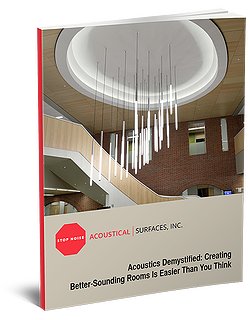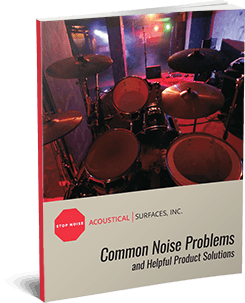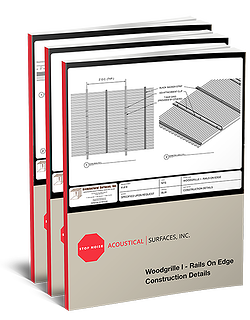Schools and Classrooms
Educational Acoustics
Introduction:
Acoustics is not as complicated as people generally think it is. Reverberation (echo) is simply a relationship between the size of the space and the surfaces that make up the space. The intent of this article is to help you start to understand how that relationship works and how to help or eliminate an echo problem.
Please keep in mind that if you would like to discuss your specific situation please feel free to contact me via phone or E-mail which are at the bottom of this page. I have a background and degree in education, K12 Art to be specific. Although I am not currently teaching, I have a good idea where you are coming from. I know that you do not have time to sit down and study sound and how it works. I would like to try to make it simple, so here goes.
- How many panels do I need?
The answer to this question depends on how quiet you need the space which ultimately up to you, but here is a place to start. This equation was developed as an average – a starting point to figure out how many acoustical panels needed per room.
Multiply the room dimensions:
Height x width x depth, then multiply that number by 3%. The number that you end up with is approximate total square feet of paneling needed for your room.
Example:
If your classroom is 25′ wide, 45′ deep and has 10′ tall ceilings, your equation would look like this:
25 x 45 x 10 = 11,250 cubic feet of volume
11,250 x .03 = 337.5
This room needs approximately 337.5 square feet of panels.
- Where should the panels be installed?
Put the panels wherever you want. Most commonly, acoustical panels are put on the walls near the ceiling. Keeping the panels out of the reach of children will greatly extend their life, as I am sure you can imagine. Acoustically speaking, a room with 45 acoustical panels placed evenly on all four walls will sound exactly the same as an identical room with the same 45 panels placed on the ceiling, or on the floor for that matter. Echo control is done with quantity, not placement.
- Contact me:
PLEASE feel free to contact me by phone or E-mail. I would be happy to address your questions individually. Digital photos sent via E-mail are a great help in my grasp of your room, and the problems that may exist. It is my job to help you.
- Products:
The products below are the three most common acoustical treatments sold to schools – the Echo Eliminator being the most popular simply due to cost. I will explain the pros and cons of each, as well as giving a BALLPARK price for each. Please do not rely on this document as a quote, call me if you need a quote or have any questions.
Cost: 1″ thickness $4.00 per square foot/2″ thickness: $5.50 per square foot
Pros: Extremely cost effective, very absorbent, 100% recycled cotton fiber, light weight, class A/1 Fire rated, easy to install, cost effective to ship, nine different colors, fiberglass free, in-stock
Cons: Does not look as finished as other panels, is not considered ‘cleanable’, size limited to 2 ‘x 4’ panels
Cost: 1″ thickness $5.50 per square foot/2″ thickness: $7.50 per square foot
Pros: Cleanable, tack-able, light weight, water and impact resistant, cost effective to ship, class A/1 Fire rated, non-fibrous, in-stock
Cons: Not as acoustically absorbent as some other panels, fairly costly, limited number of colors, size limited to 2′ x 4′ panels
Cost: 1″ thickness, approx. $6.50 per square foot/2″ approx. $12.00 per square foot
Pros: Very acoustically absorbent, panel sizes customizable, great color selection, four different edge options, Class A/1 Fire rated
Cons: Fairly costly, lead time is between one-and-three weeks, shipping only via LTL on a pallet




2 Comments
jchoy1021
I have a 2-car garage, unfinished, that I would like to sound-proof and use it as a band room for my sons. What would be an effective and economical way of doing it? Would the sound-proofing make it inbarable for the ban members to pratice due to the fact that the sound would retain in the room?
J.C.
Ted W
J.C.
Thank you for posting. Your question is a little tricky, but I will do my best to answer it as directly as possible.
“Sound Proofing” the garage should not change the ammount of echo and reverberation that the band members experience in the room. The only change that the soundproofing will have is the amount of sound that leaves the space will be reduced.
If it were my garage, I would absolutely go with the RSIC-1 Clip system. I have gotten more positive feedback from people who have gone this route than any of our other products. The system is going to require some construction on your part, but overall, performance compared to cost, this is going to be one of, if not THE, most cost effective solutions that we have to offer.
Dealing with the echo in the room is another story all together. If the band is practicing in a room with sheetrock walls and ceiling and a concrete floor, the sound in the room very well may be ear splitting. I would use the Three-Percent suggestion noted above and cover some of the walls with either the 1″ or 2″ thick Echo Eliminator panels. These panels are some of the most cost effective panels on the market. They would simply apply directly to the walls with adhesive.
My suggestion would be to look at the proposed project as a two phaze process. Deal with the “sound proofing” first INSIDE of the walls, and then “tune” the room with the acoustical panels after the drywall is installed, and you’ve taped, mudded, and painted.
I hope this helps, please feel free to call or E-mail if I did not adequately answer your questions, or if you woudl like a quote on any of our products.
Thanks,
Ted